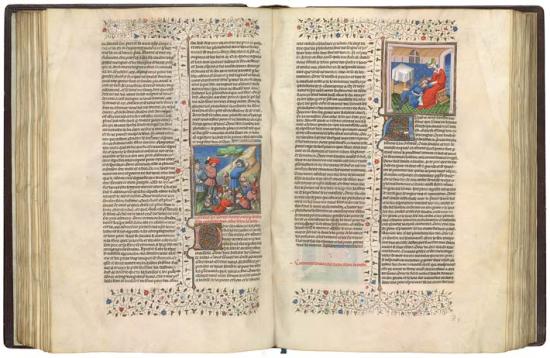
Bible historiale, in French
Illuminated by the workshop of the Boucicaut Master
Purchased by Pierpont Morgan, 1910
Taunted by the Philistines, a swashbuckling Samson slew a thousand of them with the jawbone of an ass, as depicted in the left miniature. They got their revenge, bribing Delilah to solve the mystery of his superhuman strength. She then got Samson drunk and cut off the source of his power — his hair. Delilah wears a trailing, high-waisted houpeland with bulbous sleeves and an open V-shaped collar. The horns of her temples (hennin), stretching wider than her shoulders, are surmounted by a decorative green burlet from which hangs a short veil. The horizontal embroidery and knotted sash worn by Samson signify his exoticism.
Luxury in a Time of Madness
In 1392 King Charles VI suffered the first of forty-four bouts of madness that would cripple his reign. During a lull in the Hundred Years' War, strife between France and Burgundy erupted into civil war. This domestic crisis was sparked by the 1407 assassination of Charles's brother by Duke John of Burgundy. In 1419 the duke, in turn, was murdered by supporters of the crown. During these tumultuous times, fashion reached unbelievable heights of luxury.
Men's and women's fashions were dominated by a new garment, the houpeland. Men's houpelands featured enormous sleeves and a skirt ranging from full length to crotch level. The pourpoint remained popular, albeit often finely embroidered and equipped with large sleeves. Accessories included fancy baldricks (sashes) and belts—both sometimes hung with bells. Tall bonnets or chaperons, often tied into imaginative shapes, completed the look.
Women's houpelands were always full length, with bombard or straight sleeves. The simpler cote hardy, with its voluminous skirt and tight upper body, continued to be worn. Women began to wear their hair in temples, a double-horned coif surmounted by veils or a tubular burlet.
